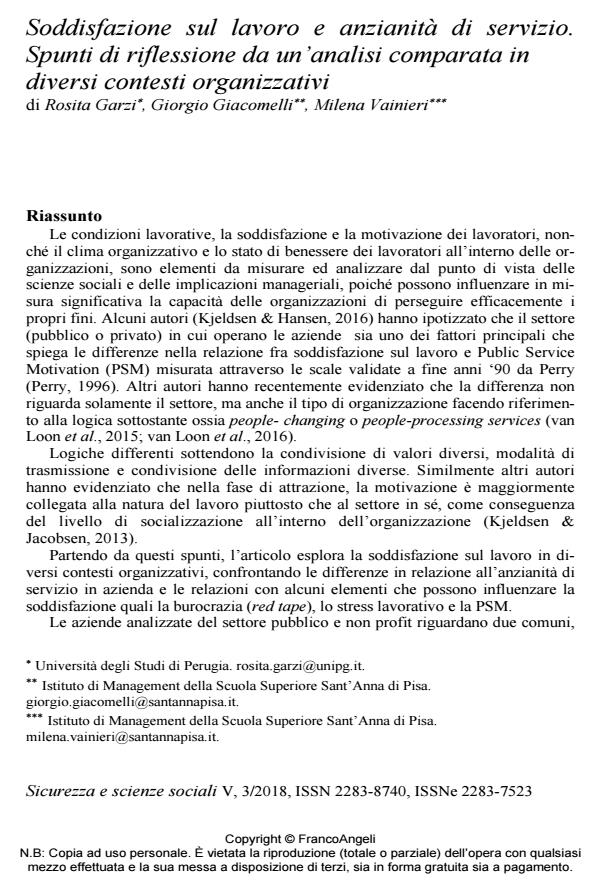Soddisfazione sul lavoro e anzianità di servizio. Spunti di riflessione da un’analisi comparata in diversi contesti organizzativi
Titolo Rivista SICUREZZA E SCIENZE SOCIALI
Autori/Curatori Rosita Garzi, Giorgio Giacomelli, Milena Vainieri
Anno di pubblicazione 2019 Fascicolo 2018/3
Lingua Italiano Numero pagine 17 P. 37-53 Dimensione file 203 KB
DOI 10.3280/SISS2018-003004
Il DOI è il codice a barre della proprietà intellettuale: per saperne di più
clicca qui
Qui sotto puoi vedere in anteprima la prima pagina di questo articolo.
Se questo articolo ti interessa, lo puoi acquistare (e scaricare in formato pdf) seguendo le facili indicazioni per acquistare il download credit. Acquista Download Credits per scaricare questo Articolo in formato PDF

FrancoAngeli è membro della Publishers International Linking Association, Inc (PILA)associazione indipendente e non profit per facilitare (attraverso i servizi tecnologici implementati da CrossRef.org) l’accesso degli studiosi ai contenuti digitali nelle pubblicazioni professionali e scientifiche
Le condizioni lavorative, la soddisfazione e la motivazione dei lavoratori, non-ché il clima organizzativo e lo stato di benessere dei lavoratori all’interno delle or-ganizzazioni, sono elementi da misurare ed analizzare dal punto di vista delle scienze sociali e delle implicazioni manageriali, poiché possono influenzare in mi-sura significativa la capacità delle organizzazioni di perseguire efficacemente i propri fini. Alcuni autori (Kjeldsen & Hansen, 2016) hanno ipotizzato che il settore (pubblico o privato) in cui operano le aziende sia uno dei fattori principali che spiega le differenze nella relazione fra soddisfazione sul lavoro e Public Service Motivation (PSM) misurata attraverso le scale validate a fine anni ‘90 da Perry (Perry, 1996). Altri autori hanno recentemente evidenziato che la differenza non riguarda solamente il settore, ma anche il tipo di organizzazione facendo riferimento alla logica sottostante ossia people- changing o people-processing services (van Loon et al., 2015; van Loon et al., 2016). Logiche differenti sottendono la condivisione di valori diversi, modalità di trasmissione e condivisione delle informazioni diverse. Similmente altri autori hanno evidenziato che nella fase di attrazione, la motivazione è maggiormente collegata alla natura del lavoro piuttosto che al settore in sé, come conseguenza del livello di socializzazione all’interno dell’organizzazione (Kjeldsen & Jacobsen, 2013). Partendo da questi spunti, l’articolo esplora la soddisfazione sul lavoro in di-versi contesti organizzativi, confrontando le differenze in relazione all’anzianità di servizio in azienda e le relazioni con alcuni elementi che possono influenzare la soddisfazione quali la burocrazia (red tape), lo stress lavorativo e la PSM. Le aziende analizzate del settore pubblico e non profit riguardano due comuni, due cooperative sociali e tre aziende sanitarie che insistono nel territorio umbro. Tutti i dipendenti di queste aziende sono stati invitati a compilare un questionario di clima e benessere organizzativo nel 2016 via CAWI (maggiori informazioni sul questionario sono consultabili su Pizzini & Furlan, 2012; Sabina et al., 2016 e Cappello & Garzi, 2017) raccogliendo un totale di 2698 questionari.
Parole chiave:Soddisfazione sul lavoro; Public Service Motivation; organizza-zioni; anzianità di servizio; burocrazia, stress lavorativo.
- Evaluating Climate between Working Excellence and Organizational Innovation: What Comes First? Isabella Bonacci, Andrea Mazzitelli, Donato Morea, in Sustainability /2020 pp.3340
DOI: 10.3390/su12083340
Rosita Garzi, Giorgio Giacomelli, Milena Vainieri, Soddisfazione sul lavoro e anzianità di servizio. Spunti di riflessione da un’analisi comparata in diversi contesti organizzativi in "SICUREZZA E SCIENZE SOCIALI" 3/2018, pp 37-53, DOI: 10.3280/SISS2018-003004